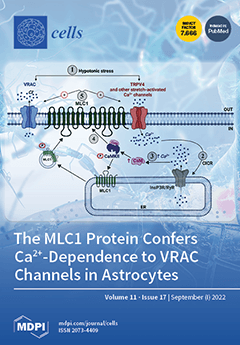Beta-amyloid (Aβ) has a dual role, both as an important factor in the pathology of Alzheimer’s disease and as a regulator in brain physiology. The inhibitory effect of Aβ
42 oligomers on Na,K-ATPase contributes to neuronal dysfunction in Alzheimer’s disease. Still, the physiological
[...] Read more.
Beta-amyloid (Aβ) has a dual role, both as an important factor in the pathology of Alzheimer’s disease and as a regulator in brain physiology. The inhibitory effect of Aβ
42 oligomers on Na,K-ATPase contributes to neuronal dysfunction in Alzheimer’s disease. Still, the physiological role of the monomeric form of Aβ
42 interaction with Na,K-ATPase remains unclear. We report that Na,K-ATPase serves as a receptor for Aβ
42 monomer, triggering Src kinase activation. The co-localization of Aβ
42 with α1- and β1-subunits of Na,K-ATPase, and Na,K-ATPase with Src kinase in SH-SY5Y neuroblastoma cells, was observed. Treatment of cells with 100 nM Aβ
42 causes Src kinase activation, but does not alter Na,K-ATPase transport activity. The interaction of Aβ
42 with α1β1 Na,K-ATPase isozyme leads to activation of Src kinase associated with the enzyme. Notably, prevention of Na,K-ATPase:Src kinase interaction by a specific inhibitor pNaKtide disrupts the Aβ-induced Src kinase activation. Stimulatory effect of Aβ
42 on Src kinase was lost under hypoxic conditions, which was similar to the effect of specific Na,K-ATPase ligands, the cardiotonic steroids. Our findings identify Na,K-ATPase as a Aβ
42 receptor, thus opening a prospect on exploring the physiological and pathological Src kinase activation caused by Aβ
42 in the nervous system.
Full article






